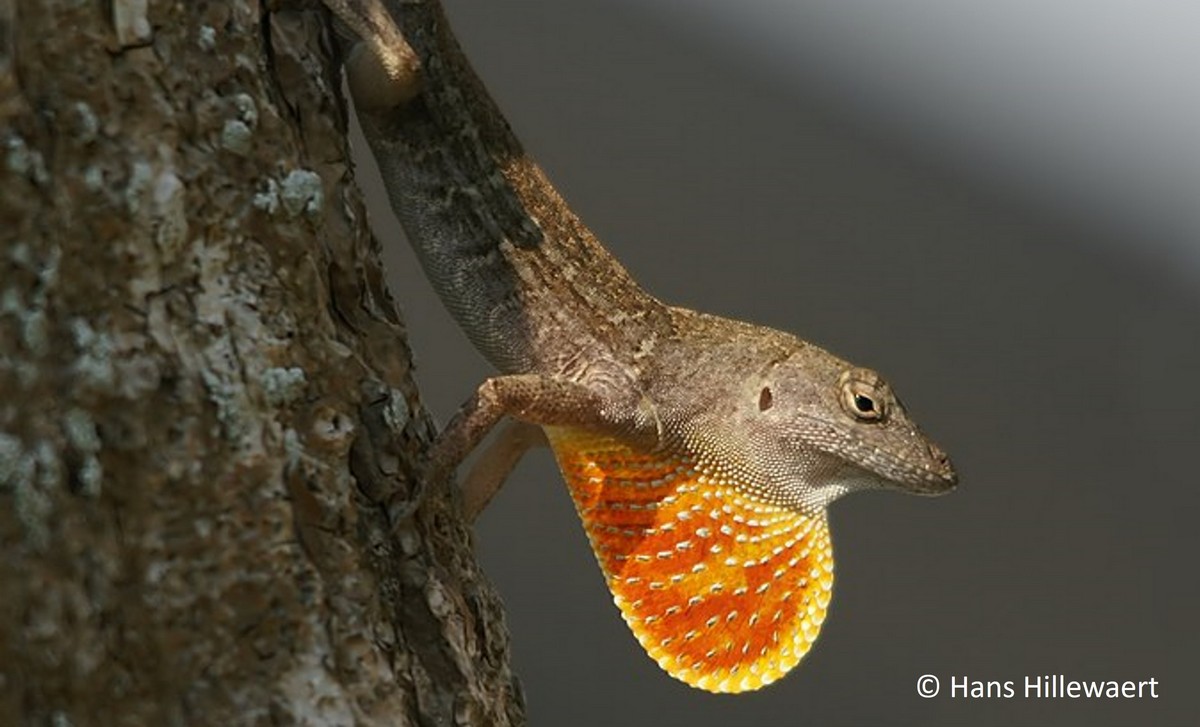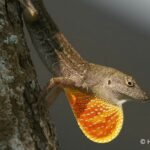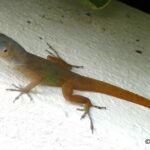
- Common name: Cuban brown anole, Brown anole
- Nom scientifique : Anolis sagrei (Duméril and Bibron, 1837)
- Nom local : Mayan coastal anole, Bahaman brown anole, Anole brun, Anole marron.
- Order : Dactyloidae
- Family : Squamata
Description
Morphology. Anolis sagrei is a medium sized anole. The body is generally light brown, with darker brown and black marks on the back, as well as lighter stripes and spots on the flanks. The dewlap is orange-red with a yellow border. The tail is compressed laterally.
Standard body size (snout-vent length). males: 70 to 90 mm; females: 30 to 59 mm
Sexual dimorphism. Only males have a dewlap. Some adult males present a dorsal crest.
Females are smaller than males, present fewer spots, but do have a white stripe bordered by darker triangular patterns along the dorsal spine.
Variations. The body colour of the same individual can vary from light to dark, depending on its physiological condition.
Head colour variations have been reported (red and orange heads).
Possible confusion with other species. The confusion is possible with A. cristatellus. However, the dorsal crest in A. cristatellus extends from the tail to the nape, and is always erected.
Distribution
Native. Bahamas, Cuba.
Introduced. Hawai (Kolbe et al., 2004), California, Texas, Louisiana, North Carolina, Georgia, Florida (Lee, 1985; Lee et al., 1989; Kolbe et al., 2004; Wen et al., 2019; Fisher et al., 2020), Mexico (Pazos-Nava et al., 2019), Belize (Eales and Thorpe, 2010), Honduras (Fisher et al., 2020; Reynolds et al., 2020), Panama (Batista et al., 2019), Ecuador (Amador et al., 2017), Brazil (Oliveira et al., 2018), Bermuda (Stroud et al., 2017), Taiwan (Norval et al., 2016), Singapore (Tan and Lim, 2012), Israel (Reptile-database: Shai Meiri, pers. comm., 29 Apr 2021).
Caribbean: Turks and Caicos (Burgess, 2012), Jamaica (Poe and Anderson, 2019), Dominican Republic (Rojas-Gonzalez et al., 2020); Cayman islands (Eales and Thrope, 2010), Anguilla (Williams and Carter, 2015), Saint Lucia (Williams et al., 2019), Saint Vincent and the Grenadines (Powell and Henderson, 2007; Hite et al., 2008; Treglia et al., 2008; Eales and Thorpe, 2010), et Grenada (Greene et al., 2002; Kolbe et al., 2004).
Biology and ecology
Habitat. Anolis sagrei can cope with a great diversity of natural and anthropized habitats. However, the species appears more abundant in open environments.
Diet. Mainly insectivore and carnivore (e.g. Corey et al., 2004; Orfinger, 2018). Can also feed on fruits, berries and flower nectar.
Reproduction. Reproduction is seasonal, from March-April to August-September, but can also happen throughout the year under favourable conditions (Lee et al., 1989; Tokarz et al., 1998). The female lays one to two eggs under the leaf litter (Lee et al., 1989). Several eggs can be laid during the breeding season, at intervals of one to two weeks (Lee et al., 1989; Delaney et al., 2016).
Behaviour. Males may use several visual signals, such as dewlap extensions, head-bobbing and push-ups, in order to defend their territory, or when looking for a breeding partner (Simon, 2007; Anzai et al., 2015). These signals are also used to disturb and dissuade predators (Simon, 2007).
Impact and management of introduced populations
Impact. On several small Florida islands, the sympatric presence of Anolis sagrei with the native species A. carolinensis has resulted in a character displacement: A. carolinensis moved to higher perches, and evolved larger toepads after only twenty generations (Stuart et al., 2014).
Another study conducted in Saint Vincent revealed that the presence of A. sagrei did not resulted in a shift toward higher perches in the native species A. griseus and A. trinitatus (Treglia et al., 2008).
In the Bahamas (within the species native range), the presence of A. sagrei results in a significant reduction in abundance and diversity of spiders, highlighting the potential impact of the species on arthropod communities in introduced regions (Schoener et Toft, 1983).
Management. To date, no targeted control measures have been established in the different regions where the species has been introduced.
Bibliographie
- Amador, L., Ayala-Varela, F., Nárvaez, A. E., Cruz, K., & Torres-Carvajal, O. (2017). First record of the invasive Brown Anole, Anolis sagrei Duméril & Bibron, 1837 (Squamata: Iguanidae: Dactyloinae), in South America. Check List, 13.
- Anzai, W., Cádiz, A., & Endo, H. (2015). Sexual dimorphisms of appendicular musculoskeletal morphology related to social displayin Cuban anolis lizards. Zoological Science, 32, 438–446.
- Batista, A., Ponce, M., Garcés, O., Lassiter, E., & Miranda, M. (2019). Silent pirates: Anolis sagrei duméril & bibron, 1837 (squamata, dactyloidae) taking over panama city, panama. Check List, 15, 455–459.
- Burgess, J. (2012). Cuban Brown Anoles (Anolis sagrei) in the Turks & Caicos Islands. IRCF Reptiles and Amphibians, 19, 263–264.
- Cates, C. D., Delaney, D. M., Buckelew, A. M., Durso, A. M., French, S. S., Reedy, A. M., & Warner, D. A. (2004). Anolis sagrei (brown anole). Cannibalism. Herpetological Review, 45, 491.
- Delaney, D. M., Lovern, M. B., & Warner, D. A. (2016). Does reduced perch availability affect Reproduction in the Brown anole? An experimental test in the laboratory. Journal of Herpetology, 50.
- Eales, J., Thorpe, R. S., & Malhotra, A. (2010). Colonization history and genetic diversity: adaptive potential in early stage invasions. Molecular Ecology, 19, 2858–2869.
- Fisher, S. R., Del Pinto, L. A., & Fisher, R. N. (2020). Establishment of brown anoles (Anolis sagrei) across a southern California county and potential interactions with a native lizard species. PeerJ, 8, e8937.
- Greene, B. T., Yorks, D. T., Parmerlee, J. S., & Henderson, R. W. (2002). Discovery of Anolis sagrei in Grenada with comments on its potential impact on native anoles. Caribbean Journal of Science, 38, 270–272.
- Hite, J. L., Rodríguez Gómez, C. A., Larimer, S. C., Díaz-Lameiro, A. M., & Powell, R. (2008). Anoles of St. Vincent (Squamata: Polychrotidae): Population densities and structural habitat use. Caribbean Journal of Science, 44, 102–115.
- Kolbe, J. J., Glor, R. E., Schettino, L. R., Lara, A. C., Larson, A., & Losos, J. B. (2004). Genetic variation increases during biological invasion by a Cuban lizard. Nature, 431, 177–181.
- Lee, J. C. (1985). Anolis sagrei in Florida : phenetics of a colonizing species I . Meristic Characters. American Society of Ichthyologists and Herpetologists, 1, 182–194.
- Lee, J. C., Clayton, D., Eisenstein, S., & Perez, I. (1989). The reproductive cycle of Anolis sagrei in Southern Florida. Copeia, 1989, 930–937.
- Norval, G., Wang, G.-Q., Mao, J.-J., Liu, L.-X., Chuang, M.-H., Yang, Y.-J., … Brown, L. R. (2016). The known distribution of an invasive lizard, the Brown Anole (Anolis sagrei Duméril & Bibron, 1837), in Taiwan. IRCF Reptiles and Amphibians, 23, 62–67.
- Oliveira, J. C. F., de Castro, T. M., Vrcibradic, D., Drago, M. C., & Prates, I. (2018). A second Caribbean anole lizard species introduced to Brazil. Herpetology Notes, 11, 761–764.
- Orfinger, A. B. (2018). Anolis sagrei (Brown Anole). Ophiophagy. Herpetological Review, 49, 108–168.
- Pazos-Nava, F. N., Álvaro-Montejo, R. I., Cupul-Magaña, F. G., García de Quevedo-Machain, R., Flores-Guerrero, U. S., Velasco, J. A., & Escobedo-Galván, A. H. (2019). First verified record of Anolis sagrei Cocteau in Duméril and Bibron, 1837 from the central Pacific coast of Mexico. BioInvasions Records, 8.
- Poe, S., & Anderson, C. G. (2019). The existence and evolution of morphotypes in Anolis lizards: Coexistence patterns, not adaptive radiations, distinguish mainland and island faunas. PeerJ, 2019.
- Powell, R., & Henderson, R. W. (2007). The St. Vincent (Lesser Antilles) herpetofauna: conservation concerns. Applied Herpetology, 4, 295–312.
- Reynolds, R. G., Kolbe, J. J., Glor, R. E., López-Darias, M., Gómez Pourroy, C. V., Harrison, A. S., … Losos, J. B. (2020). Phylogeographic and phenotypic outcomes of brown anole colonization across the Caribbean provide insight into the beginning stages of an adaptive radiation. Journal of Evolutionary Biology, 33, 468–494.
- Rojas-González, J. A., Araujo-Calzado, P. J., Frías-Victoriano, E. D. J., Rosa-Delgado, N. N., & Rosso-Muñoz, L. (2020). Distribution and ecological aspects of anolis (Squamata, dactyloidae) on the main campus of the universidad autónoma de santo domingo, Santo Domingo, Dominican Republic. Check List, 16, 1615–1620.
- Schoener, T. W., & Toft, C. A. (1983). Spider populations: extraordinarily high densities on islands without top predators. Science, 21, 1353–1355.
- Simon, V. B. (2007). Not all signals are equal: male brown anole lizards (Anolis sagrei) selectively decrease pushup frequency following a simulated predatory attack. Ethology, 113, 793–801.
- Stroud, J. T., Giery, S. T., & Outerbridge, M. E. (2017). Establishment of Anolis sagrei on Bermuda represents a novel ecological threat to Critically Endangered Bermuda skinks (Plestiodon longirostris). Biological Invasions, 19, 1723–1731.
- Stuart, Y. E., Campbell, T. S., Hohenlohe, P. A., Reynolds, R. G., Revell, L. J., & Losos, J. B. (2014). Rapid evolution of a native species following invasion by a congener. Science, 346, 463–466.
- Tan, H. H., & Lim, K. K. P. (2012). Recent introduction of the Brown Anole Norops sagrei (Reptilia: Squamata: Dactyloidae) to Singapore. Nature in Singapore, 5, 359–362.
- Tokarz, R. R., McMann, S., Seitz, L., & John-Alder, H. (1998). Plasma corticosterone and testosterone levels during the annual reproductive cycle of male Brown Anoles (Anolis sagrei). Physiological Zoology, 71, 139–146.
- Treglia, M. L., Muensch, A. J., Powell, R., & Parmerlee, J. S. (2008). Invasive Anolis sagrei on St. Vincent and its potential impact on Perch heights of Anolis trinitatis. Caribbean Journal of Science, 44, 251–256.
- Wen, F., Ljustina, O., & Domini, J. (2019). Geographic distribution. Anolis sagrei (Brown Anole). USA: Louisana. Herpetological Review, 50, 524.
- Williams, R. J., & Carter, D. (2015). Cuban Brown Anoles (Anolis sagrei) in Anguilla. IRCF Reptiles and Amphibians, 22, 182–183.
- Williams, R. J., Morton, M. N., Daltry, J. C., & Toussaint, A. (2019). The distribution of non-native Anolis lizards on Saint Lucia, Lesser Antilles. Caribbean Journal of Science, 49, 281.





